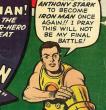VSP and Dynamic Forces signed comics6398
|
|
3JJr private msg quote post Address this user | |
Quote:Originally Posted by Nuffsaid111 A fantastic group! |
||
| Post 26 • IP flag post | ||
 CBCS Pressing CBCS Pressing
|
SteveRicketts private msg quote post Address this user | |
Quote:Originally Posted by 3JJr That's a very detailed analysis. You must have a background in autograph analysis, or at least a vested interest in it.  |
||
| Post 27 • IP flag post | ||
|
|
3JJr private msg quote post Address this user | |
Quote:Originally Posted by SteveRicketts Extensive autograph collecting background. Very varied interests too. Sports, movie, comic hobby, etc. Autograph collecting was my initial hobby. Mother, grandmother, great grand-uncle, all autograph hounds. I started out with an instant autograph collection put together for me by the family before I could even read the written names! |
||
| Post 28 • IP flag post | ||
 CBCS Pressing CBCS Pressing
|
SteveRicketts private msg quote post Address this user | |
Quote:Originally Posted by 3JJr Very cool. I assume you still have the collection. How far back does it go? Who are your oldest and rarest signatures? |
||
| Post 29 • IP flag post | ||
 Ima gonna steal this and look for some occasion to use it! Ima gonna steal this and look for some occasion to use it!
|
IronMan private msg quote post Address this user | |
| 3Jjr does a lot of great detail. Maybe I shouldn't bother commenting. But that wouldn't be me.... I've yet to see a signature rejected as a forgery. What I've seen are signatures that "could not be verified". Obviously there is a difference. Some authentic signatures are probably getting rejected. That's better than lots of forgeries getting passed. |
||
| Post 30 • IP flag post | ||
|
|
teacha777 private msg quote post Address this user | |
I have had 2 jim lee signatures i obtained when x-men#1 was released in the 90's for verification and it passed. I'd assume original posters sigs are fake  |
||
| Post 31 • IP flag post | ||
|
|
3JJr private msg quote post Address this user | |
Quote:Originally Posted by IronMan I'm giving very little technical detail about the signature. Just that the top half of the 'S' and the terminus of the signature could have possibly been penned by Lee, if Stan were sitting or standing a certain way. Our signatures, the varying degrees of the trajectories, angles, pressures, and slants that occur during the act of signing are subject to the position of our entire body. Like a anything else, the body works harmoniously. Synergistically. Links in a chain. Our writing mechanism isn't just our hand at the point we're holding the implement. It's the hand, wrist, arm, shoulder, etc., the subtle motion of each that works as a whole that gives our signatures their individuality, therefore us ability to identify fake or real. It's unwise to go into great detail as to why everything went wrong for this forger between 3% in and 3% out. While it may be helpful to some to go into detail helping hobbyists spot the tells in the forgeries, it would definitely help the forger to improve his efforts. Most autograph experts do not have the same level of expertise in all signatures. This is where many false positives and negatives occur, when authenticators have to review exemplars for comparison. The best authenticating is done by someone with expert level in identifying a/or certain signatures. This is someone who has probably seen as many of that signor's signature as his own. Authenticating is a visual, subjective art. When authenticators try to invent a system using a mold for signatures, and reject those outside of that parameter that they have created by borrowing the coordinates from a number of other signatures, things get dicey and go wrong. Of course, there are elements like chronology, a signor having a certain style at a certain time, and the viability of the materials, but the real experts can gauge the authenticity of a certain signature without having to resort to exemplars or templates. |
||
| Post 32 • IP flag post | ||
 Collector Collector
|
BabaLament private msg quote post Address this user | |
| So what about change over time? Stan Lee is probably the best example, or William Shatner as a close second; two guys who have been signing autographs since the dawn of time. As they’ve aged, their signatures have changed; so can you tell by analysis not only if their signatures are legitimate, but around what period of their work the signature was signed (based on samples from the different periods)? | ||
| Post 33 • IP flag post | ||
|
|
3JJr private msg quote post Address this user | |
Quote:Originally Posted by BabaLament Yes. And again, samples are typically a mediocre substitute for knowing on sight. This is why there's no substitute for real specialists. A jack of all trades type expert relies on exemplars. He has a basic knowledge of many autographs and uses exemplars to assist his decisions. The specialist is extremely adept in a limited number of signatures. To someone like this, recognizing the ink of a Stan Lee, or the Beatles, or Elvis, etc., is akin to their recognizing their faces. If you want the definitive word on any particular auto, there is a specialist out there to consult on it who has the visual recognition of that particular signor's handwriting down cold. The ink "speaks" to this type of expert. |
||
| Post 34 • IP flag post | ||
 FORMER CBCS FORMER CBCS
|
Jake_Fleming private msg quote post Address this user | |
Quote:Originally Posted by IronMan IronMan is correct. You have not, nor will you see us say something is a forgery as it isn't a judgment call we make. We only ever verify something that we are confident in saying is the real deal, and if there is doubt of it's authenticity, we would not give it that seal of approval. IronMan is probably correct in assuming that some real signatures will fail from time to time. I hear it on the phone occasionally "I got that myself! How could it fail?!". I believe them, and understand the frustration, but the signature fails regardless. |
||
| Post 35 • IP flag post | ||
 I'm good with splotches. I'm good with splotches.
|
Nuffsaid111 private msg quote post Address this user | |
Quote:Originally Posted by Jake_Fleming I am very very happy to hear there is such stringency in the signature verification process; even if some fail that are real. It gives me peace of mind and hopefully the red label will be seen as just as desireable as the yellow label over time. |
||
| Post 36 • IP flag post | ||
This topic is archived. Start new topic?
